Ant Course 2018
This year, the 17th Ant Course was held in French Guiana at the stunning and remote Inselberg research station of Nouragues Nature Reserve, which contains over 76,000 hectares of neotropical rainforest. A total of eighteen students from Argentina, Australia, Brazil, France, Germany, Japan, USA, and Singapore spent every waking hour observing, sampling, mounting, and identifying the diverse local ant fauna and learning about various aspects of ant biology, including taxonomy and systematics, evolution, ecology, and functional morphology. The course was organized by Brian Fisher with local coordinator Jérôme Orivel and instructed by Brian, Phil Ward, Jack Longino, Christian Peeters, and Mélanie Fichaux. In this photoblog contribution, Ant Course 2018 students Mark Wong and Philipp Hoenle share highlights of their experience as well as some of the ants that they encountered during the course.
A Photoblog contribution by Mark Wong and Philipp Hoenle

Arrival
The journey to the isolated research station involved the use of a helicopter. The flight offered a spectacular view of the jungle, as well as a glimpse of the majestic Inselberg, the 400-metre high ‘rock island’. (© Mark Wong)
Station
The beautiful research station at Nouragues, located in the middle of the rainforest, was our home away from home. (© Brian Fisher)

Sampling
During the course, we were introduced to a variety of methods for sampling ants from different habitats. Here, Phil Ward demonstrates his modus operandi, beating vegetation, which he employs for collecting arboreal ants such as species of Pseudomyrmex. (© Mark Wong)

Sorting
Students in the lab sorting, mounting, and identifying the ants they collected. A major component of every Ant Course is learning to develop and curate a personal ant collection and to identify the ants to genus level. These basic skills are emphasised as they are fundamental to research across the broad fields of taxonomy, ecology, evolution, and many others. (© Brian Fisher)

Fungus growers
One cannot visit the Neotropics without encountering the famous fungus-growing ants. We found plenty of those from the very start; already in Cayenne, the capital of French Guiana, we observed the large colonies of leaf-cutting Atta near the coastline. In another location close to the city, a forested pathway revealed one exceptionally beautiful colony of Acromyrmex: it was located directly under a log, providing an excellent opportunity for a close examination of the fungus garden and the ants’ behaviours. Later, deeper in the rainforest, we would also find the smaller and more cryptic colonies of the incredibly diverse fungus growers, such as species of Myrmicocrypta, Apterostigma, and Cyphomyrmex. (© Mark Wong)

Allomerus & Allomerus ovaries
One of the most fascinating ants of French Guiana is a little myrmicine belonging to a rather small genus, Allomerus decematriculatus. These ants live in close association with a plant (Hirtella physophora) and construct complex structures covering parts of their nest. The structures are stabilized with the help of a fungus and have many holes which are proposed to serve as a trap for capturing insect prey. During the course, a small part of a colony was collected, and the queen was found inside the plant stem. Judging by the typically large colony size, the queen of this species must be capable of producing large quantities of eggs. A careful dissection by instructor Christian Peeters showed that this indeed seemed to be the case. He revealed the queen’s ovaries under the microscope, so that every student was able to admire this important royal organ. (top picture © Philipp Hoenle; bottom picture © Brian Fisher)
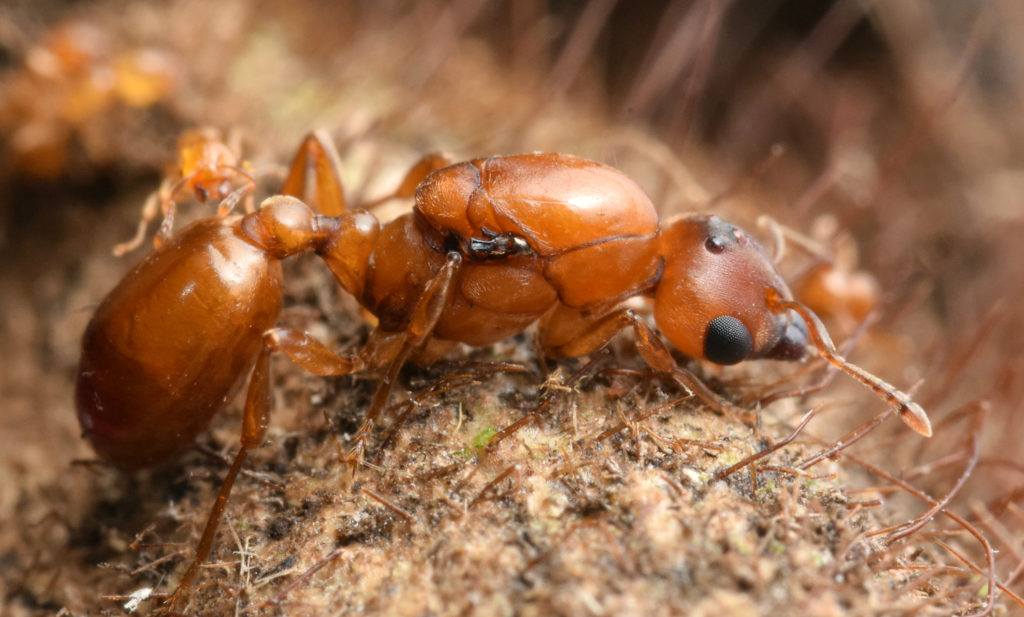

Crematogaster–Ectatomma video
Late one night, we made an interesting discovery: A Crematogaster species would surround workers of Ectatomma tuberculatum, and then proceed to take some of the sweet honeydew that the larger ants were carrying in their mandibles. In addition, there was a whole trail of Crematogaster entering the characteristic nest entrance of the Ectatomma. Intrigued by this, we recorded a video of it. It turns out that this interaction has been described as a form of cleptoparasitism, although we could only wonder why there were no obvious signs of aggressions towards the thiefs. (© Philipp Hoenle)
Gigantiops
One of the most prominent and common ants of the Amazon area is Gigantiops destructor. As their name (“large eyed destroyer”) suggests, these ants have massive eyes, which give them more resemblance to a mantis. However, they are quite timid and certainly not destructive. It was such a pleasure to watch the foragers navigate their complex environment, jumping from leaf to leaf, and hunting down smaller insects. Not only do these ants recognize their prey visually, but they also have the remarkable ability to see and flee from any approaching myrmecologist! (© Philipp Hoenle)
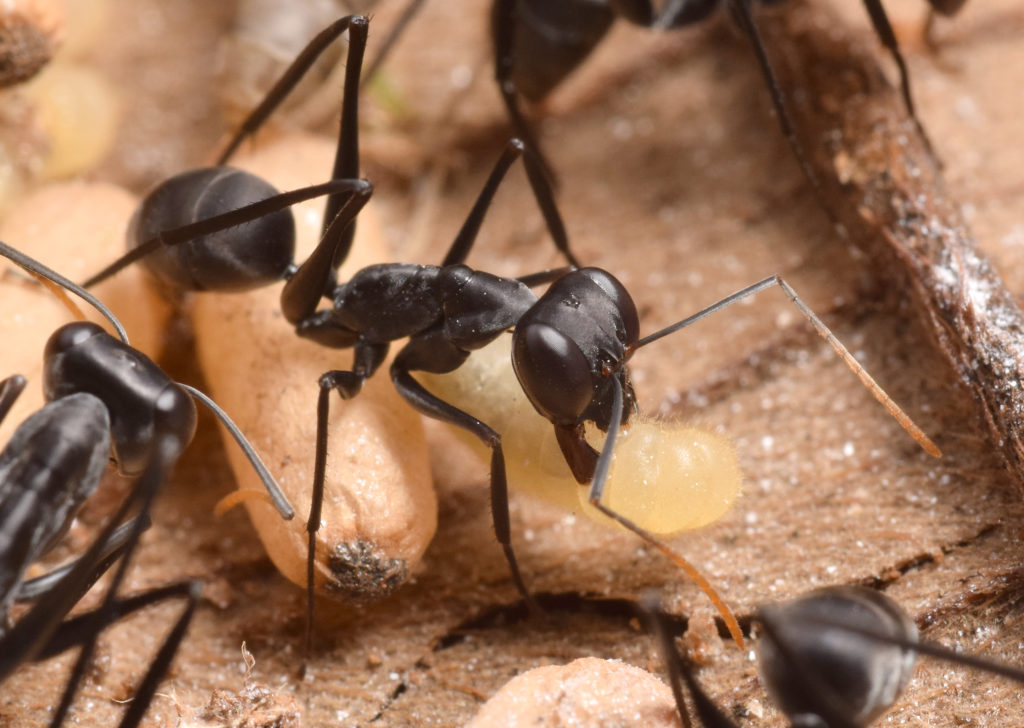
Eciton with brood & Eciton with Vatesus
The army ants are among the most formidable predators of tropical rainforests, and we were very excited to find them. In South America, army ants of the genus Eciton are the most common, forming large raiding columns and hunting down their prey. They are easily recognized by their large majors with sickle-shaped mandibles. During our ten days at the station, we found four species of this genus! While observing a raid by Eciton hamatum during the day, we even located their bivouac beneath a fallen tree. Knowing of their nomadic lifestyle, we returned at night to observe the spectacular migration of the whole colony – a large, seemingly never-ending column of ants moving in one direction across the forest floor, carrying their brood and prey. We also observed numerous army-ant associates that migrated within the column to the new nest. These included specialized staphylinid beetles mimicking the ants’ appearance (so-called myrmecoids, genus Ecitophya) as well as the tear-shaped ‘red tanks’ of the genus Vatesus. Both these beetles are obligatory army ant myrmecophiles and possibly have a parasitic lifestyle inside the ant colony; through chemical disguises they are left unharmed by their hosts. (© Philipp Hoenle)
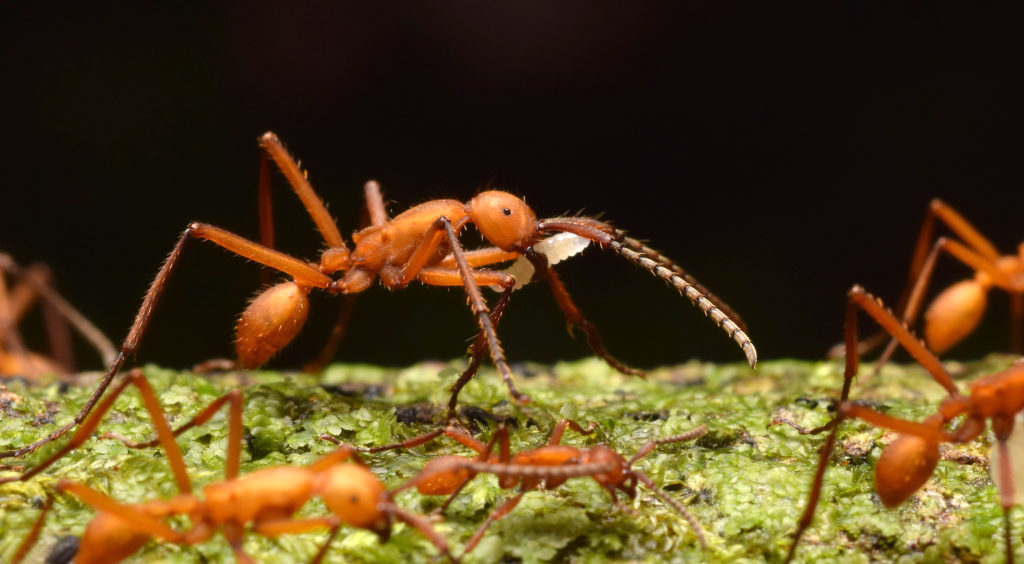
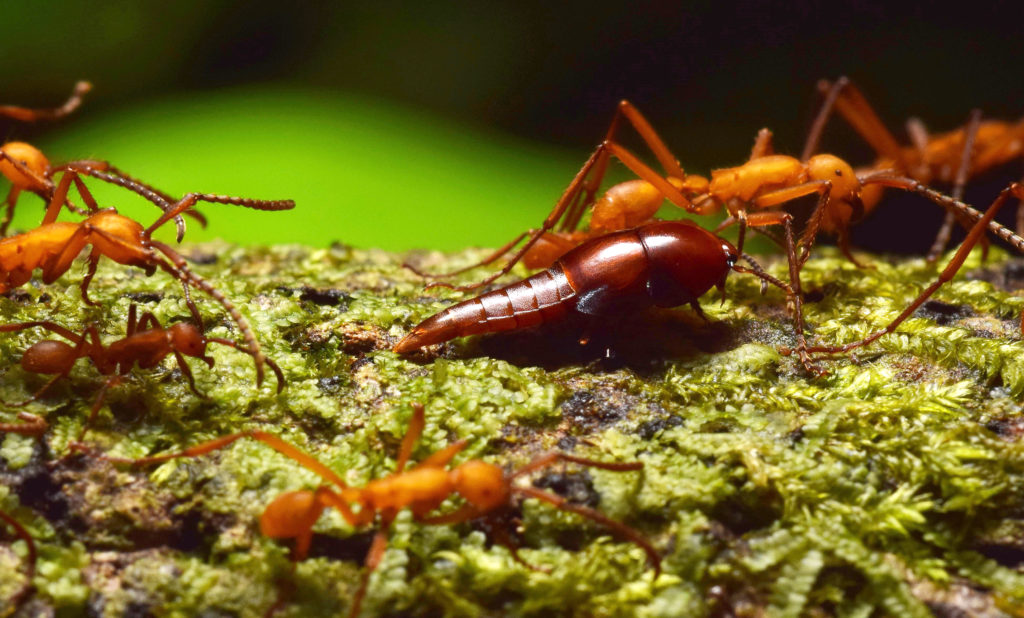
Acanthostichus & Neocerapachys
The army ant subfamily Dorylinae also encompasses many surprisingly rare and cryptic species. While many of these are not easy to find due to their predominantly hypogaeic lifestyle, luck was on our side, and we collected not one but two uncommon genera. The first were species of Acanthostichus, which were found by searching under fallen logs and also through the employment of subterranean pitfall traps baited with tuna oil. Perhaps even more spectacular, we serendipitously encountered a small queen-right colony of the genus Neocerapachys during the excavation of a Gigantiops destructor nest! Apparently nothing is known about the biology of Neocerapachys, but our little nest contained several larvae of the same size, which might suggest a nomadic lifestyle with cyclic brood production, as is known from other dorylines. (top picture © Mark Wong; bottom picture © Philipp Hoenle).


Inselberg group, Inselberg view, Daceton, and Daceton video
One morning, we hiked to the summit of Inselberg, the 400-metre high ‘rock island’ which overlooks the Nouragues reserve. Watching the sun rise over the vast rainforest was definitely one of the highlights of the course. Fuelling our motivation for the hike were also some rumours that there were interesting ants nesting at the top of Inselberg. And indeed, upon reaching the summit, we encountered a large Daceton armigerum colony nesting in a tree! The photo below shows instructor Christian Peeters with a worker demonstrating the impressive flexibility of this arboreal species. In a video of another colony encountered during the course, these adorable trap-jaw ants can be seen using their powerful mandibles, head, and pronotal muscles to lift a large fly (Tabanidae) that was offered to the foragers. (top picture © Philipp Hoenle; middle picture © Brian Fisher, last picture + video © Mark Wong).

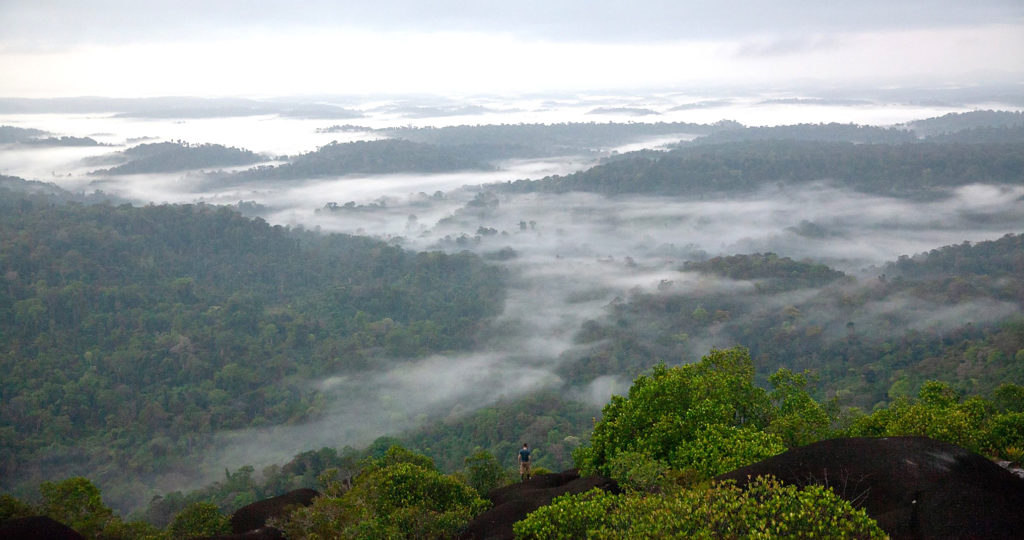
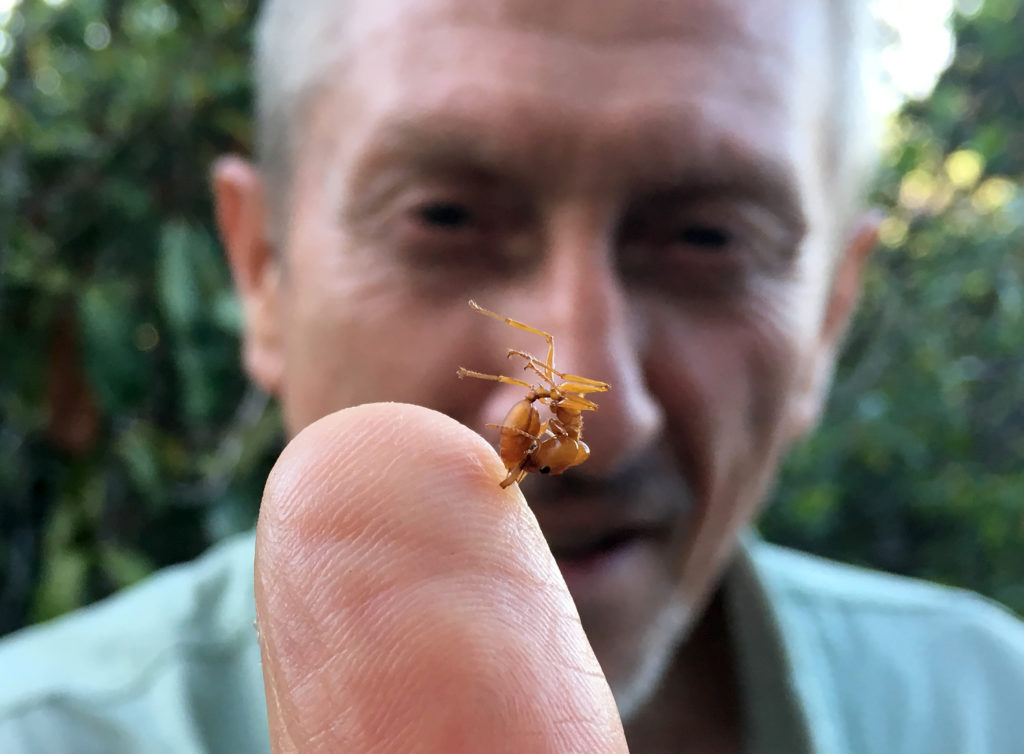
Group projects
Another enjoyable and enriching component of Ant Course was a series of collaborative group projects, where students worked together to collect and analyse data, and presented their findings to the course. In this photo, several students enjoy a lively discussion on their ecological study of dietary partitioning among litter ant communities in Nouragues. (© Brian Fisher)
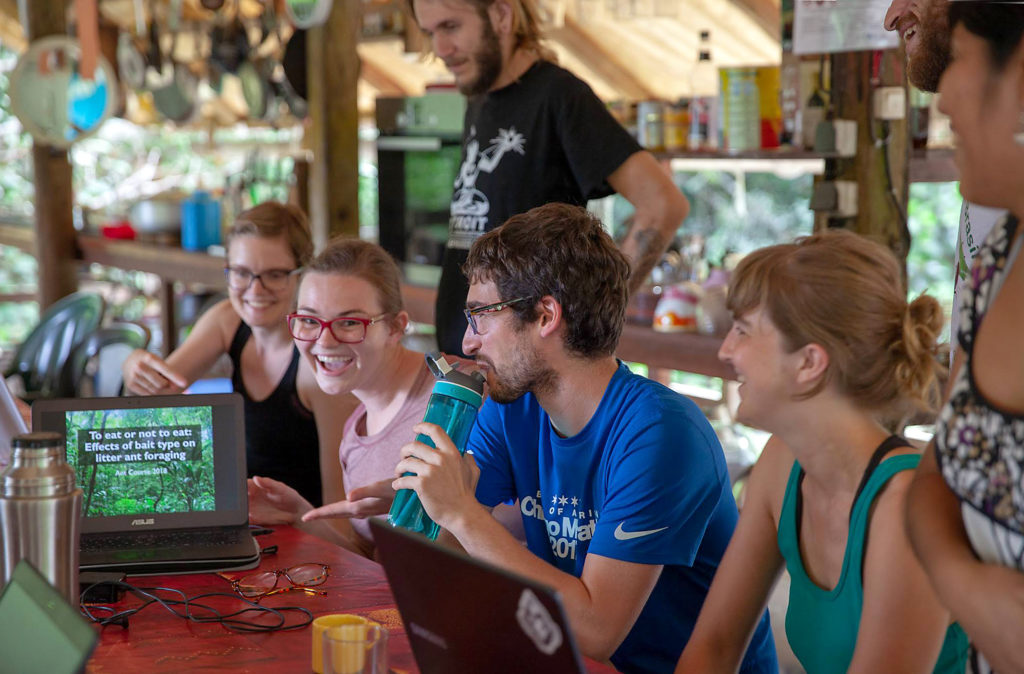
Neoponera apicalis
When in the forest, it was hard not to stumble upon the beautifully large ponerines, Neoponera apicalis, which were very abundant. This ant is easily recognized by its yellow antennal tips that are always nervously in movement. It is a hunter with good visual capabilities. During the course, we excavated a complete nest containing approximately 60 workers from a rotten log. Their sting is quite memorable! (© Philipp Hoenle)
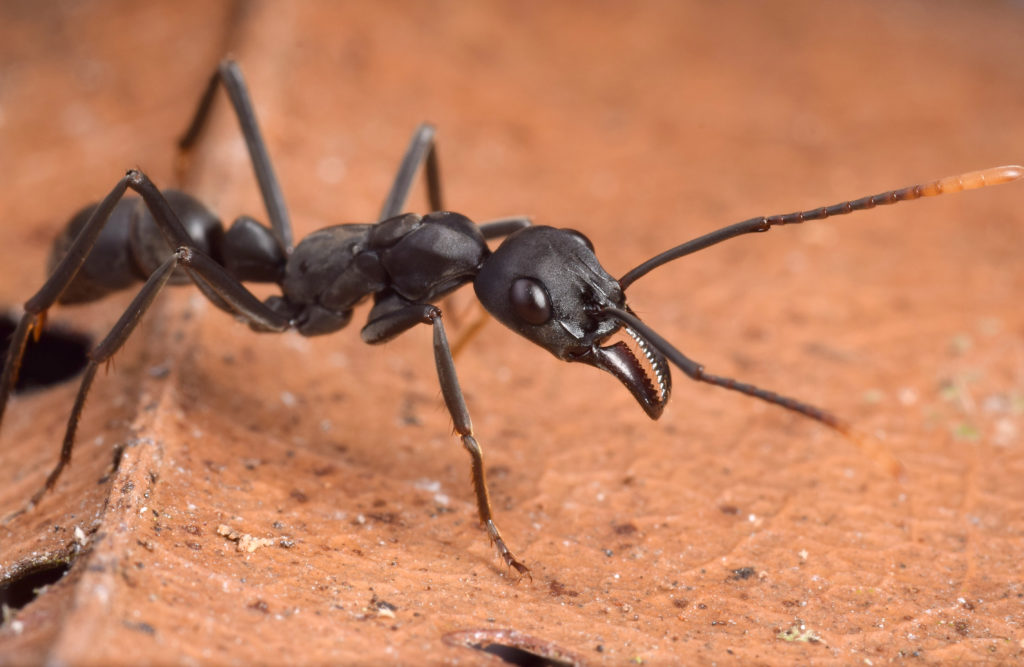
Talaridris mandibularis
With so many keen hands in the field, it was only a matter of time before rare ants started turning up in collections. Among the most exciting finds were two individuals of the extremely rare myrmicine, Talaridris mandibularis, which were collected in students’ Winkler extractions of leaf litter. (© Mark Wong)

Review, Phil’s graduation, Mark’s graduation,and departure video
Towards the end of the course, the instructors reviewed the collections of ants that we had enthusiastically caught, delicately point-mounted, and painstakingly identified to genus level. Only after passing this test could all eighteen of us students proudly graduate from the 17th Ant Course and receive a diploma hand-signed by the course organizer Brian Fisher and the course advisor E.O. Wilson. Soon it was time to say goodbye, but not without a little more fun; the departure from the station entailed another helicopter flight, and a subsequent four-hour boat ride along the scenic Approuague river. A fitting end to a fantastic Ant Course! (top picture © Mark Wong; middle and bottom picture © Brian Fisher; video © Mark Wong).

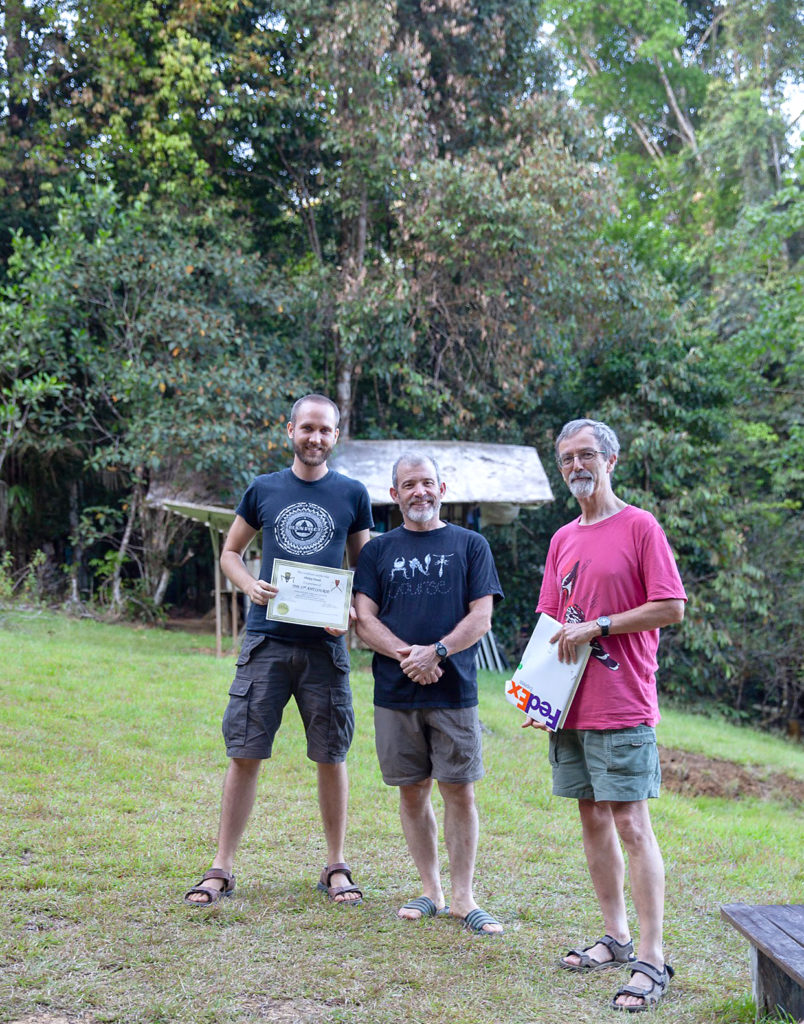

Ant Course 2018 participants
The participants of Ant Course 2018, displaying their geniculate antennae. From left, first row: Naoto Idogawa, Julie Miller, Cedric Cheny, Alexandre Ferreira, Peter Flynn, Maria Brito de Almeida, and Pamela Pairo; second row: Charlotte Francoeur, Melanie Fichaux (Instructor), Iryna Ivasyk, Christian Peeters (Instructor), Brian Fisher (Instructor), Ms Ascension (Chef), Frederic Petitclerc, Lily Leahy, Philipp Hoenle, Phil Ward (Instructor), Jack Longino (Instructor), Rachel Wells, Jason Williams, Jill Oberski, Adam Khalife, Mark Wong, and Cody Cardenas. (© Brian Fisher).

Acknowledgements
Ant Course was funded by an Investissement d’Avenir grant from the Agence Nationale de la Recherche (CEBA, ANR-10-LABX-25-01). We are grateful to the Nouragues Natural Reserve for allowing our ant collections in the protected area and to the Nouragues Research Station and CNRS Guyane for logistical support.


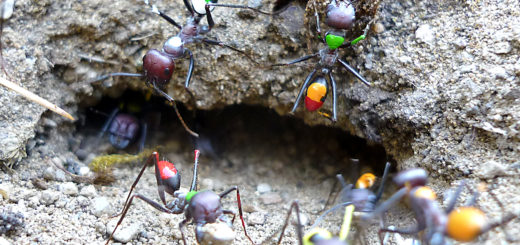
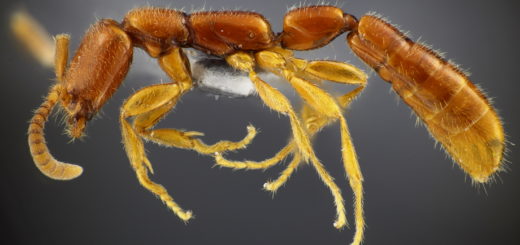
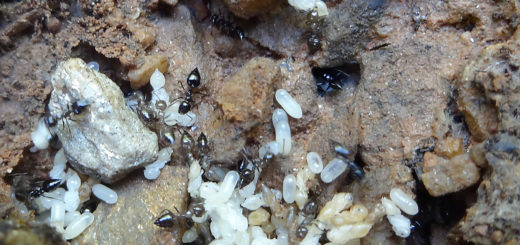
So cool!! I wish I could be a student!!!! Thanks Mark and Phillip for sharing the great photos and wonderfull ant stories. It transported me all the way to the jungle, that I miss so much, so thanks again.
Any thoughts about how and why Ectatomma allows those Crematogaster to feed from her? Very interesting!